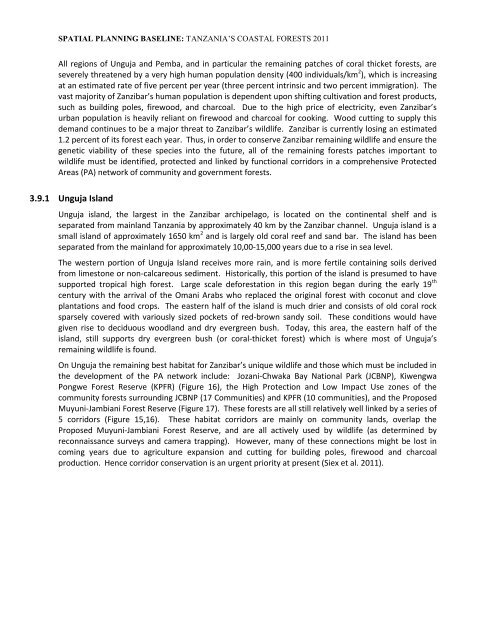Neil D. Burgess, Paul Harrison, Peter Sumbi, James Laizer, Adam ...
Neil D. Burgess, Paul Harrison, Peter Sumbi, James Laizer, Adam ...
Neil D. Burgess, Paul Harrison, Peter Sumbi, James Laizer, Adam ...
You also want an ePaper? Increase the reach of your titles
YUMPU automatically turns print PDFs into web optimized ePapers that Google loves.
SPATIAL PLANNING BASELINE: TANZANIA’S COASTAL FORESTS 2011<br />
All regions of Unguja and Pemba, and in particular the remaining patches of coral thicket forests, are<br />
severely threatened by a very high human population density (400 individuals/km 2 ), which is increasing<br />
at an estimated rate of five percent per year (three percent intrinsic and two percent immigration). The<br />
vast majority of Zanzibar’s human population is dependent upon shifting cultivation and forest products,<br />
such as building poles, firewood, and charcoal. Due to the high price of electricity, even Zanzibar’s<br />
urban population is heavily reliant on firewood and charcoal for cooking. Wood cutting to supply this<br />
demand continues to be a major threat to Zanzibar’s wildlife. Zanzibar is currently losing an estimated<br />
1.2 percent of its forest each year. Thus, in order to conserve Zanzibar remaining wildlife and ensure the<br />
genetic viability of these species into the future, all of the remaining forests patches important to<br />
wildlife must be identified, protected and linked by functional corridors in a comprehensive Protected<br />
Areas (PA) network of community and government forests.<br />
3.9.1 Unguja Island<br />
Unguja island, the largest in the Zanzibar archipelago, is located on the continental shelf and is<br />
separated from mainland Tanzania by approximately 40 km by the Zanzibar channel. Unguja island is a<br />
small island of approximately 1650 km 2 and is largely old coral reef and sand bar. The island has been<br />
separated from the mainland for approximately 10,00-15,000 years due to a rise in sea level.<br />
The western portion of Unguja Island receives more rain, and is more fertile containing soils derived<br />
from limestone or non-calcareous sediment. Historically, this portion of the island is presumed to have<br />
supported tropical high forest. Large scale deforestation in this region began during the early 19 th<br />
century with the arrival of the Omani Arabs who replaced the original forest with coconut and clove<br />
plantations and food crops. The eastern half of the island is much drier and consists of old coral rock<br />
sparsely covered with variously sized pockets of red-brown sandy soil. These conditions would have<br />
given rise to deciduous woodland and dry evergreen bush. Today, this area, the eastern half of the<br />
island, still supports dry evergreen bush (or coral-thicket forest) which is where most of Unguja’s<br />
remaining wildlife is found.<br />
On Unguja the remaining best habitat for Zanzibar’s unique wildlife and those which must be included in<br />
the development of the PA network include: Jozani-Chwaka Bay National Park (JCBNP), Kiwengwa<br />
Pongwe Forest Reserve (KPFR) (Figure 16), the High Protection and Low Impact Use zones of the<br />
community forests surrounding JCBNP (17 Communities) and KPFR (10 communities), and the Proposed<br />
Muyuni-Jambiani Forest Reserve (Figure 17). These forests are all still relatively well linked by a series of<br />
5 corridors (Figure 15,16). These habitat corridors are mainly on community lands, overlap the<br />
Proposed Muyuni-Jambiani Forest Reserve, and are all actively used by wildlife (as determined by<br />
reconnaissance surveys and camera trapping). However, many of these connections might be lost in<br />
coming years due to agriculture expansion and cutting for building poles, firewood and charcoal<br />
production. Hence corridor conservation is an urgent priority at present (Siex et al. 2011).

















